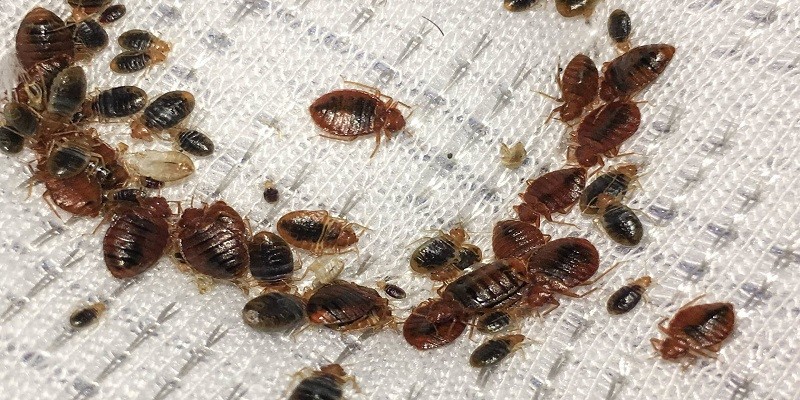Last Updated on November 24, 2023
Baby bed bugs, also known as nymphs, are smaller and lighter in color than adult bed bugs. They are about the size of a pinhead and appear translucent or white, but turn reddish-brown after feeding on blood.
Bed bugs are a common nuisance and infestations can be difficult to deal with. Identifying baby bed bugs is crucial during an infestation as they are less visible than adult bed bugs. Baby bed bugs are often found in the seams or crevices of mattresses, bed frames, and other furniture.
They can also be found in clothing, luggage, and other personal items. Proper identification and treatment are essential for eradicating a bed bug infestation. In this article, we will delve further into what baby bed bugs look like and how to identify them.

Credit: www.orkin.com
What Do Baby Bed Bugs Look Like?
Description Of The Physical Appearance Of Baby Bed Bugs
Baby bed bugs, also known as nymphs, look slightly different from adult bed bugs. They are much smaller in size, and their bodies are translucent, making it easy to mistake them for something else. Here are some key physical characteristics of baby bed bugs:
- They are around 1-5mm in size
- Their bodies are oval-shaped
- They have six legs and two antennae
- They are usually pale white or yellow, but may turn reddish-brown after feeding
Comparison Of Baby Bed Bugs To Other Common Household Insects
Bed bugs are often mistaken for other household pests, such as fleas or ticks. Here is how baby bed bugs compare to some of the most commonly encountered household insects:
- Fleas: Fleas have longer legs and are better jumpers than bed bugs. They also tend to be darker in color.
- Ticks: Ticks have a distinct head and are often larger than bed bugs. They also attach themselves to their host for a longer period of time.
- Cockroaches: Cockroaches have a long, flattened body and long antennae.
Knowing the differences between these household insects is important to properly identify a bed bug infestation.
Importance Of Knowing How To Identify Baby Bed Bugs
Being able to identify baby bed bugs is crucial because it allows you to take action quickly. If an infestation is left unchecked, it can spread rapidly, making it harder and more expensive to treat. Early detection of bed bugs is the key to successful treatment and preventing further complications.
Furthermore, proper identification of bed bugs can help to prevent misdiagnosis. Bed bugs are often mistaken for hives or other skin rashes. Knowing what baby bed bugs look like can prevent unnecessary medical treatment and expenses.
To sum up, knowing what baby bed bugs look like is crucial to detect an infestation early on and to get the proper treatment quickly. Identifying baby bed bugs is the first step in getting rid of them, and it can also prevent mistaken diagnoses and extra expenses.
Identifying Baby Bed Bugs In Your Home
Baby bed bugs are tiny, oval-shaped insects that are often found in bedding and mattresses. These pests can be difficult to spot, and an infestation can rapidly escalate if not dealt with immediately. In this section, we’ll delve into the key points for identifying baby bed bugs in your home.
Explanation Of Where Baby Bed Bugs Are Commonly Found
Baby bed bugs, also known as nymphs, are often found in close proximity to their food source – human blood. As such, they are commonly found:
- In mattresses, box springs, bed frames, and headboards
- In cracks and crevices in walls, floors, and furniture
- Behind wallpaper, baseboards, and electrical outlets
- In curtains, carpeting, and other fabric-based items
Signs Of A Baby Bed Bug Infestation
It’s essential to identify an infestation early on to prevent it from spreading. Signs of a baby bed bug infestation include:
- Unexplained bites on your skin, usually in a line or group of three
- Bloodstains on your sheets, pillows, or mattress
- Small, dark spots on your bedding, which could be fecal matter from the bed bugs
- A sweet, musty odor, which could be emanating from the bugs’ scent glands
- Shed exoskeletons in and around your bed or furniture
Tips For Identifying Baby Bed Bugs In Your Home
Identifying baby bed bugs can be tricky, as they are quite small and can hide in the tiniest of spaces. Here are some tips to help you spot them:
- Look for bugs that are translucent or light brown in color, with a flat, oval-shaped body and six tiny legs.
- Check your bed and mattress thoroughly, paying close attention to seams, creases, and folds.
- Use a flashlight to search for the bugs in dark corners, crevices, and cracks.
- Inspect other furniture and fabric-based items in your home, such as curtains and rugs.
- Use bed bug traps and detectors, which can help you identify and monitor the presence of bed bugs in your home.
By being vigilant and taking appropriate steps to identify and eradicate baby bed bugs in your home, you can keep your family safe and make sure that these pesky insects don’t cause any harm.
Preventing And Eliminating Baby Bed Bugs
What Do Baby Bed Bugs Look Like?
Bed bugs are a common household pest that can cause discomfort and annoyance. However, baby bed bugs can be particularly difficult to detect and eliminate. This article will focus on preventing and eliminating baby bed bugs in your home.
Ways To Prevent Baby Bed Bugs From Entering Your Home
Prevention is key when it comes to avoiding baby bed bugs. To minimize your chances of encountering these pests, follow these tips:
- Inspect second-hand furniture and bedding before purchasing or bringing them into your home.
- Use a protective cover for your mattress and box spring.
- Seal any cracks or crevices around windows, doors, and baseboards.
- When traveling, check hotel rooms for signs of bed bugs and keep your luggage off the floor.
- Regularly vacuum and clean all surfaces in your home, paying close attention to the areas near your bed.
Natural And Chemical Solutions For Eliminating Baby Bed Bugs
If you suspect a baby bed bug infestation, there are several steps you can take to eliminate them:
- Wash and dry all bedding, clothing, and linens on the hottest setting.
- Use a high-powered vacuum to clean all surfaces and crevices in your bedroom and surrounding areas.
- Apply heat to infected areas using a steam cleaner, which can effectively kill bed bugs and their eggs.
- Use chemical treatments, such as pesticides or insecticides, as a last resort and follow all safety instructions carefully.
- Consider using natural remedies, such as diatomaceous earth or essential oils, to repel bed bugs and discourage them from returning.
Importance Of Seeking Professional Help For Severe Infestations
While these prevention and elimination methods may be effective for minor infestations, severe infestations may require professional help. Pest control professionals have the knowledge and tools to effectively eliminate bed bugs and ensure they do not return.
Preventing and eliminating baby bed bugs can be a challenge, but with the right strategies and tools, you can effectively combat these pests. By taking a proactive approach and seeking professional help when needed, you can keep your home bed bug-free and comfortable.
Frequently Asked Questions Of What Do Baby Bed Bugs Look Like?
What Do Baby Bed Bugs Look Like To The Naked Eye?
Baby bed bugs, also known as nymphs, are tiny translucent insects about the size of a pinhead.
What Is The Color Of A Baby Bed Bug?
Baby bed bugs are usually pale white or yellowish in color, almost transparent.
Do Baby Bed Bugs Have Wings?
No, baby bed bugs do not have wings and cannot fly or jump like fleas.
Where Do Baby Bed Bugs Hide?
Baby bed bugs typically hide in mattress crevices, cracks in walls, and other tight spaces.
How Do Baby Bed Bugs Feed?
Baby bed bugs feed on the blood of humans or animals by piercing the skin with their tiny mouthparts.
Conclusion
After reading this article, you should have a clear idea of what baby bed bugs look like and how to differentiate them from their adult counterparts. Baby bed bugs are tiny, translucent, and almost colorless, making them difficult to spot with the naked eye.
It’s important to inspect your bedding and furniture regularly, especially if you suspect a bed bug infestation. Taking swift action to eliminate these pests is crucial in preventing them from spreading and causing further harm. Remember to always consult a professional pest control service if you suspect a bed bug infestation, as they have the knowledge and tools to effectively rid your home of these pesky insects.
With this newfound knowledge, you can take proactive steps to keep your home bed bug-free and ensure a peaceful night’s sleep.







